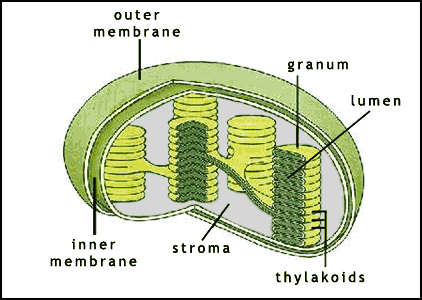Summary 8.1
-the chloroplasts is the cellular organelle where photosynthesis takes place
-chloroplasts contain chemical compounds called chlorophyll's that give these organelles a green color
-the leaves contain the most chloroplasts and are the site for most photosynthesis
-the chloroplasts are concentrated in the cells of the mesophyll, the inner layer of tissue, within a leaf
-Stomata, the tiny pores on the surface of the leaf letting CO2 enter the leaf and oxygen exit the leaf through this pore
-The veins carry water and nutrients from roots to the leaves delivering organic molecules produced in the leaves to other parts
-chloroplast's structure is important like a mitochondria
-Have an inner and an outer membrane with a thick fluid called stroma in inner membrane
-disk-shaped sacs called thylakoids are in the stroma are many
-thylakoids are in stacks, grana
-the opposite of cellular respiration occurs in photosynthesis
-Electrons from water are boosted by the energy from sunlight allowing chlorplasts to use elecrtrons CO2 and hydrogen ions to produce sugar
 |
-Photosynthesis occurs in two main stages: the light reactions and the Calvin cycle
 |
-The light reactions convert the energy in sunlight to chemical energy.
- chlorophyll capture light energy to remove electrons from water splitting into oxygen and hydrogen ions
-oxygen is waste making energy rich products NADPH and ATP.
-The Calvin Cycle makes sugar from carbon dioxide, hydrogen ions and the electrons carried by NADPH
- enzymes for the Calvin cycle are outside the thylakoids, dissolved in the stroma.
-ATP made by the light reactions provides the energy to make sugar
- Calvin cycle does not directly require light to begin
-Calvin cycle requires two inputs supplied by the light reactions, ATP and NADPH.
Concept Check 8.11. Draw and label a simple diagram of a chloroplast that includes the following structures: outer and inner membranes, stroma, thylakoids.
 http://www.helpsavetheclimate.com/chloroplast1.gif
http://www.helpsavetheclimate.com/chloroplast1.gif2. What are the reactants for photosynthesis? What are the products?
The reactants for photosynthesis are 6 Carbon Dioxide molecules and 6 Water molecules. The products are glucose and 6 oxygen molecules.
3. Name the two main stages of photosynthesis. How are the two stages related?
The two main stages of photosynthesis are the light reactions and the Calvin cycle. The two stages are related in that they are both working together to make photosynthesis a possible action and that they both concert sunlight into chemical energy used for plants. These stages both help create ATP using sunlight and the Calvin cycle follows the stage of the light reaction.


0 comments:
Post a Comment